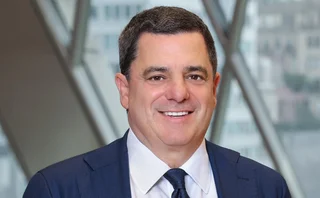
OTC client clearer of the year: Bank of America
Risk Awards 2020: Pivot to Europe pays off with market share growth and big client wins

Clearing firms began 2019 caught between a rock and a hard Brexit.
On the one hand, these businesses are under intense pressure to cut costs to offset higher capital charges, which have made clearing unprofitable for many banks. Several European banks have already scaled back or shuttered their clearing units as a result. On the other hand, those that remain had to invest heavily in their European operations to prepare for a no-deal Brexit, which would have prevented European Union clients from clearing trades via the UK subsidiaries of global banks.
“Many in the market feared that, in a hard-Brexit scenario, licensing from the UK to Europe would be lost,” says Emma West, head of futures, options and over-the-counter clearing in Europe, the Middle East and Africa (Emea) at Bank of America. “In such a scenario, this could have meant that EU clients would not have been able to face a London-based entity for the purposes of clearing.”
BofA made a virtue of this dire necessity. It promptly established a legal entity in the EU for existing clients and shifted a team of clearing experts to its new trading hub in Paris, where the bank now has around 400 staff. Clients were informed of the firm’s Brexit plans at the end of 2018, with positions physically moving in March.
The firm’s Brexit planning wins rave reviews from clients, and earned it a cluster of new OTC clearing mandates, including new business from the investment arm of Nordea and Dutch asset manager NN Investment Partners. Two of Europe’s largest pension fund managers and another big asset manager are in the process of onboarding, while at least two other sizeable clients have increased the amount of trades they clear through BofA at the expense of its rivals.
The total amount of OTC initial margin the bank posts to central counterparties (CCPs) on behalf of clients is up 35% for this year to November 26, compared with the same period last year, while trade counts and notionals are up 30%. The firm is targeting double-digit growth in annual revenues.
The Brexit migration was a major undertaking. There were two distinct stages to the move. The first involved moving OTC and listed trades from Bank of America Merrill Lynch International in the UK to the new European legal entity, BofA Securities Europe SA, and setting up legal relationships with almost all existing European clients to face the EU entity.
The second involved completing exchange and CCP memberships ahead of the original Brexit deadline of March 29, 2019, to ensure that clearing would continue without disruption, no matter what happened.
“All CCP memberships for the European entity were completed at the open of 2019, and all clients that had to be moved, were moved by March 29,” says Rajeev Kumar, head of Emea futures, options and OTC clearing sales at BofA.
BofA has been very proactive and supportive in its and Aegon’s Brexit planning, and has been transparent with its messaging from the outset, which has been a clear differentiator from some of its peers
Marvin Brizee, Aegon
Other major clearers carried out similar moves to BofA, setting up fresh legal entities and migrating EU clients, but none were as comprehensive or accommodating as BofA, say buy-side firms.
“BofA has been very proactive and supportive in its and Aegon’s Brexit planning, and has been transparent with its messaging from the outset, which has been a clear differentiator from some of its peers,” says Marvin Brizee, head of group treasury trading and services at Dutch pension fund Aegon.
Christian Måhrbeck, head of derivatives operations at Nordea Investment Management, says BofA was the first clearing broker to present a plan for moving to a new EU entity: “The transition of our in-scope EU funds from facing a UK clearing broker entity to a European legal entity in line with Brexit was seamlessly executed by BofA.”
In addition to setting up a new legal entity, BofA put boots on the ground in the form of a team of clearing execution and clearing sales specialists dispatched to the new Paris-based office.
In a highly politically charged atmosphere during often acrimonious negotiations among political leaders, having a physical presence in the EU was reassuring for clients. Pan-European securities regulator European Securities and Markets Authority warned that setting up letterbox entities in Europe should not be tolerated. There have been some concerns among local regulators in places such as Frankfurt and Paris about banks outsourcing substantial activities back to London or other jurisdictions.

Establishing a fully staffed office in Europe has also opened up a pool of potential new clients for BofA. “We are being invited into more RFPs [requests for proposal] as a result of the move to Paris,” adds BofA’s Kumar. “Historically, we have not been weak in Europe, but the new EU-based entity and hub has been a catalyst. Clients invite us to their offices a lot, and having local speakers situated in Europe has gone down well with French clients.”
Despite the slew of new European mandates, the firm has a lot more work to do to wrestle market share away from JP Morgan and Citi, which still dominate clearing in the US and Europe.
BofA could close the gap by capturing more business from existing blue-chip clients that spread their trades across a number of clearing firms to diversify their exposure. Frequent reviews of these relationships result in allocations being juggled around, as large players weigh pricing, capacity and risk management.
One of BofA’s strengths is relationship management – an often-overlooked factor – which reflects its focus on solving problems, keeping clients abreast of regulatory developments, and simply checking up on progress.
BofA’s large footprint in futures and options clearing also creates cross-selling opportunities, which is made easier by its business structure. BofA’s foreign exchange and fixed income prime brokerage, futures and options and OTC clearing businesses are all run by the same senior leadership team. All the business lines fall under Dean Tonkin, global head of futures and options, OTC clearing and forex prime brokerage.
Pension funds are another potential area of growth. BofA has recently won mandates with two large EU pension funds, with onboarding expected to complete in early 2020. Pension funds usually have large directional swaps positions to hedge bond portfolios, which can be tricky for clearers to risk-manage.
There are concerns that clearers may not have sufficient capacity to accommodate large European pension funds, but regulators do not want to provide a clearing exemption for these institutions indefinitely. While challenging, pension funds may represent the next big opportunity for clearing firms.
BofA’s engagement with large European clients, including pension funds, is underpinned by a prudent capital strategy. The firm prioritises strategic mandates and carefully manages its book of clients. All mandates are priced from a total balance sheet perspective, which means fees are dependent on capital utilisation and not on gross notional or other metrics.
However, it does not substantially review pricing after an agreement is signed if it incurs additional costs related to regulatory changes, such as the standardised approach to counterparty credit risk. The bank even tries to price in potential regulatory changes down the road so that fee changes are not necessary.
We’ve never had to change course with a client after taking them on because of the rigorous due diligence we perform upfront
Felicia Grumet, BofA
“As a business, we are cognisant of constraints firm-wide and what drives capital requirements,” says Felicia Grumet, the global head of OTC clearing and fixed income and forex prime brokerage. “We’ve never had to change course with a client after taking them on because of the rigorous due diligence we perform upfront.”
Grumet was previously head of fixed income, currencies and commodities, strategic capital and balance sheet management.
The bank is not afraid to walk away from clients that are very aggressive about pricing, opting instead for longer-term, stable client relationships. When taking on new business, BofA also considers the size of the client and the liquidity of instruments they trade – important factors highlighted by the default at Nasdaq Clearing last year. BofA’s risk team attends meetings with clients ahead of agreeing pricing and terms.
“We don’t want to be all things to all people,” says Kumar. “We are very selective, and work with key, priority names to the firm. This allows us to be in a strong position when assigning risk and initial margin limits and managing our balance sheet. It’s all about having a proactive, honest relationship with clients so they don’t blow through their limits.”
Clearing banks are also increasingly engaging with clearing houses and regulators to advocate for what they see as better risk management practices. BofA has been quieter than other futures commission merchants on some of these issues – at least, publicly. For instance, it did not put its name to a recent paper published by a consortium of clearing banks and buy-side clients that called for major changes to CCP waterfalls. Instead, it prefers to work behind the scenes.
“A thorough, considered approach to advocacy has proven to be most effective,” says West. “Part of this relies more on in-person engagement. While we are party to industry calls and present with most working groups, we find more discreet forms of engagement enable constructive dialogue with our valued clients.”
Michael Spokoyny, BofA’s head of risk and control for futures and options, OTC clearing and forex prime brokerage, is in frequent contact with clearing houses about their margin models and requirements.
Through ongoing risk monitoring, BofA, along with some other banks, noticed a decline in LCH’s margin requirements for client portfolios – an issue the clearing house rectified in July. The issue was caused by market scenarios linked to the turbulent period surrounding the default of Lehman Brothers falling out of LCH’s 10-year lookback period.
The move was generally welcomed by clearing firms that were concerned about dropping client margins at the clearing house, and was accepted with some grumbling by clients with large swaps positions.
Spokoyny and his team are closely following the launch of CME’s new historical value-at-risk-based margin methodology for futures, dubbed Span 2, which is expected to be rolled out for energy products next year.
Only users who have a paid subscription or are part of a corporate subscription are able to print or copy content.
To access these options, along with all other subscription benefits, please contact info@risk.net or view our subscription options here: http://subscriptions.risk.net/subscribe
You are currently unable to print this content. Please contact info@risk.net to find out more.
You are currently unable to copy this content. Please contact info@risk.net to find out more.
Copyright Infopro Digital Limited. All rights reserved.
As outlined in our terms and conditions, https://www.infopro-digital.com/terms-and-conditions/subscriptions/ (point 2.4), printing is limited to a single copy.
If you would like to purchase additional rights please email info@risk.net
Copyright Infopro Digital Limited. All rights reserved.
You may share this content using our article tools. As outlined in our terms and conditions, https://www.infopro-digital.com/terms-and-conditions/subscriptions/ (clause 2.4), an Authorised User may only make one copy of the materials for their own personal use. You must also comply with the restrictions in clause 2.5.
If you would like to purchase additional rights please email info@risk.net
More on Awards
Collateral management and optimisation product of the year: CloudMargin
Delivering the modern blueprint for enterprise collateral resilience
Flow market-maker of the year: Citadel Securities
Risk Awards 2026: No financing; no long-dated swaps? “No distractions,” says Esposito
Pricing and analytics: fixed income – Quantifi
Quantifi delivers high-performance, transparent and adaptable pricing and risk analytics for fixed income and credit markets
Derivatives house of the year: Citi
Risk Awards 2026: Rev up, RWAs down, as US bank gets back on track (with added XiNG and XiP)
Technology vendor of the year: SS&C Algorithmics
Risk Awards 2026: From cloud, to chips, to maths tricks – vendor getting more out of existing tech
SS&C Algorithmics: winner’s interview with Curt Burmeister
SS&C Algorithmics wins three categories in this year’s Markets Technology Awards in addition to Technology vendor of the year at the Risk Awards
Best vendor for system support and implementation: Murex
Murex wins Best vendor for system support and implementation at the Markets Technology Awards 2026
Pricing and analytics: cross-asset and structured – Murex
Murex wins Pricing and analytics: cross-asset and structured at the Markets Technology Awards 2026 thanks to its MX.3 platform







